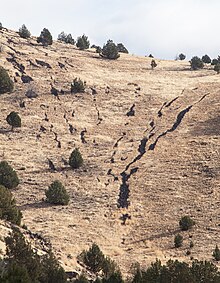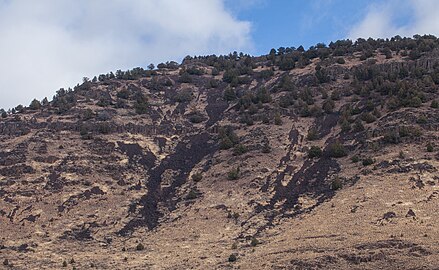Stone stripe

Astone stripe,also called alava stringer,[1]is an elongated concentration of mostlytalus-likebasaltrock found along ahillsideor the base of acliff.Many stone stripes occur without cliffs. A stone stripe is identified by its lack ofvegetative cover.They typically occur in northcentral Oregonand develop at 900 to 1,100 meter elevations. Lengths can range from only a few meters to over 150 meters, and widths measure from.3 to 3 meters. Depths of the stone stripes range from 20 to 65 centimeters.[2]
Formation
[edit]Stone stripes are thought to have been originally created byperiglacialconditions of theQuaternaryperiod during anIce age.It is likely their formation originates from multiple processes includingfrost action,surface erosion,eluviation,andmass wasting.However, it is likely that intense freeze and thaw cycles account for the natural sorting of the rock debris within a stone stripe, and also accounts for the shallow depth of the stripes, since frost penetration is thought to not penetrate deeper than 1 meter in the region.[3]
Stone stripes are also found surrounding soil mounds of central Oregon which also owe their formation to freeze and thaw cycles. They are called stone rings and form on more level terrain. As the terrain increases in slope, stone rings transition into stone stripes.[4]
Gallery
[edit]-
Stone stripes onCatlow Rimwithjunipertrees.
-
Stone stripes onCatlow Rim.
-
Stone stripes onCatlow Rim.
See also
[edit]External links
[edit]References
[edit]- ^ Maser, Chris; Geist, J. Michael; Concannon, Diane M.; Anderson, Ralph; Lovell, Burrell (1979).Wildlife Habitats in Managed Rangelands-- The Great Basin of Southeastern Oregon: Geomorphic and Edaphic Habitats.U.S. Department of Agriculture. pp. 11–12.Retrieved2016-12-01.
- ^ Pyrch, John Baine (1973).The Characteristics and Genesis of Stone Stripes in North Central Oregon.Portland State University.pp. 1–2.Retrieved2020-08-01.
- ^ Pyrch, John Baine (1973).The Characteristics and Genesis of Stone Stripes in North Central Oregon.Portland State University.pp. 111–121.Retrieved2020-08-01.
- ^ Nelson, Clark A. (1977).The Origin and Characteristics of Soil Mounds and Patterned Ground in North Central Oregon.pp. 15–16.S2CID89612259.



